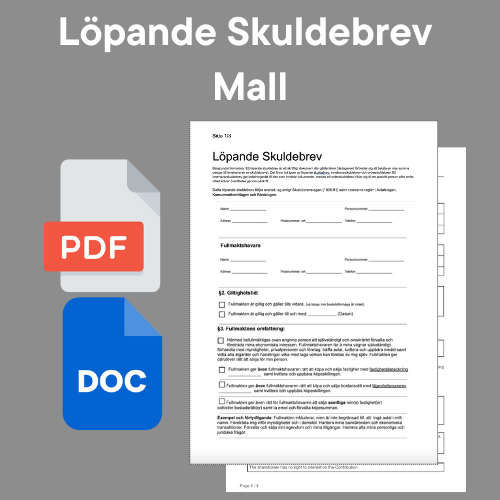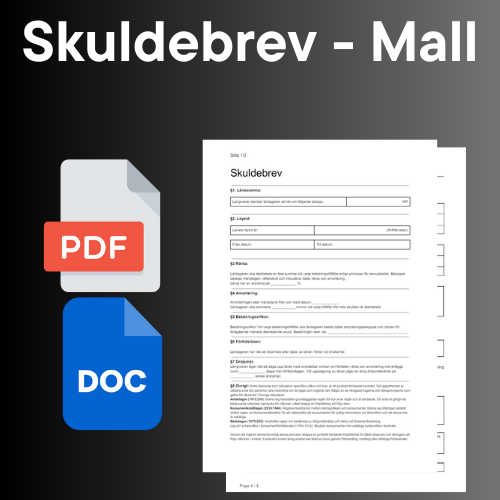Why should a promissory note be drawn up?
Share
Why you should create a promissory note
Table of Contents
- Introduction
- Definition of Promissory Note
- Important Reasons for Establishing a Promissory Note
- Practical example
- How do you establish a promissory note?
- Advantages and Disadvantages of Promissory Notes
- Common misunderstandings about promissory notes
- Legislation and Legal Aspects
- Important Considerations when Establishing Promissory Notes
- Conclusion
Introduction
A promissory note is a legal document that confirms a debt between two parties: the lender and the borrower. Promissory notes are important to ensure that loan terms are clearly documented and legally binding. This document can prevent disputes and provide clarity around repayment, interest and other terms. In this article we will explore why you should draw up a promissory note, citing legislation and practice examples.
Definition of Promissory Note
A promissory note, according to law ( Skuldebrevslagen, 1936:81 ), is a document which means that one person undertakes to pay a certain amount of money to another person. The promissory note can be simple or continuous. A simple promissory note is addressed to a certain person, while a running promissory note can be transferred to others.
Important Reasons for Establishing a Promissory Note
1. Legal Security
A promissory note gives both the lender and the borrower legal security. It serves as proof that the loan exists and what conditions apply.
2. Clarity and Clarity
By specifying the loan amount, interest, repayment period and any collateral in a promissory note, a clear agreement is created that reduces the risk of misunderstandings.
3. Evidence in Legal Disputes
If a dispute arises between the lender and the borrower, the promissory note can be used as evidence in a legal process. This increases the chance that the lender will get their money back.
4. Interest and Fees
A promissory note can specify which interest rate and which fees apply to the loan. This is particularly important to avoid uncertainty and conflicts regarding the costs of the loan.
5. Repayment plan
A promissory note can include a detailed repayment plan, making it easier for the borrower to plan their payments and for the lender to predict when the loan will be repaid.
6. Security for the Lender
In some cases, the promissory note can be linked to collateral, such as a mortgage on real property or other valuables, which gives the lender extra security should the borrower have payment problems.
Practical example
In the court case NJA 1994 p. 745, the Supreme Court decided a dispute in which a promissory note played a central role. The court determined that a properly executed promissory note could be used as evidence of a debt and that the lender was entitled to repayment under the terms of the promissory note. This case shows the importance of having a clear and legally binding promissory note.
How do you establish a promissory note?
1. Identify the Parties
Clarify who is the lender and who is the borrower.
2. Specify the loan amount
Enter the exact amount being lent.
3. Determine the Interest
Decide which interest rate should apply to the loan and how it should be calculated.
4. Repayment period
Specify when the loan is to be repaid and whether it is to be made in installments or as a one-off payment.
5. Collateral
Specify any collateral provided for the loan.
6. Signature
Both parties must sign the promissory note for it to be valid. It is also good to have witnesses who can prove that the promissory note has been signed correctly.
Advantages and Disadvantages of Promissory Notes
Advantages:
- Legal Security: A promissory note provides a legally binding agreement that protects both parties.
- Clarity: The promissory note specifies all the terms of the loan, which reduces the risk of misunderstandings and disputes.
- Evidence in Disputes: The promissory note can be used as evidence in legal proceedings.
Disadvantages:
- Complexity: Creating a promissory note can be complicated, especially if the loan terms are complex.
- Cost: Hiring legal help to prepare the promissory note can be expensive, but this is often necessary to ensure that it is accurate and valid.
- Changed Terms: If the loan terms change, the promissory note must be updated, which may involve additional costs and work.
Common misunderstandings about promissory notes
A common misunderstanding is that an oral agreement is as binding as a written promissory note. In fact, a written promissory note is much stronger in terms of evidence and easier to use in a legal dispute. Another misunderstanding is that a promissory note does not need to be detailed. A detailed promissory note reduces the risk of future conflicts and misunderstandings.
Legislation and Legal Aspects
According to the Promissory Notes Act (1936:81), a promissory note is a document that implies an obligation to pay a certain amount of money. The law distinguishes between simple and current promissory notes and regulates how these can be transferred and used as collateral. A properly drafted promissory note must meet all the requirements of the law to be valid and legally binding.
Important Considerations when Establishing Promissory Notes
- Specification of Loan Amount: Clearly state the exact amount being lent.
- Interest and Fees: Clarify which interest rate will apply and how it will be calculated.
- Repayment plan: Include a detailed plan for repaying the loan.
- Collateral: Enter any collateral provided for the loan.
- Signature and Witnesses: Both parties must sign the promissory note and it is good to have witnesses who can confirm the signature.
Conclusion
Drawing up a promissory note is an important measure to ensure fairness and clarity in loans. By clearly specifying loan terms and collateral in a legally binding document, lenders and borrowers can avoid future conflicts and legal disputes. A well-formulated promissory note, supplemented with legal advice, provides security and predictability for both parties. It is a wise investment to protect both financial and personal interests when lending money.
This article provides a comprehensive overview of why a promissory note should be drawn up, with references to relevant legislation and practice. By understanding the legal and practical aspects of a promissory note, lenders and borrowers can better prepare for future eventualities and ensure a fair and clear distribution of debt and repayment.
```



